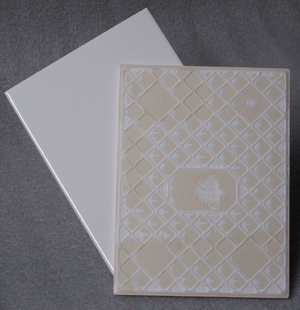Ceramic Tile Backerboards
 There are many types of backerboard products suitable for use with ceramic tile. We will focus on two of the more popular products: 1/2" thick, water resistant greenboard sheetrock and cementitious type ceramic tile backerboards (recommended).
There are many types of backerboard products suitable for use with ceramic tile. We will focus on two of the more popular products: 1/2" thick, water resistant greenboard sheetrock and cementitious type ceramic tile backerboards (recommended).Backsplashes, Shower Stalls & Tub Walls
Water resistant greenboard sheetrock should not be used for walls that will be subjected to heavy amounts of moisture. This includes but is not limited to, shower stalls and tub enclosures. Greenboard is water resistant but not water proof and will disintegrate if it is exposed to excessive amounts of moisture. It no longer is approved for use (ANSI A108) as a wet substrate. Depending on moisture conditions, this product is acceptable for use as a ceramic tile substrate in residential backsplashes and bathroom wainscotings. Wood studs should be spaced a maximum of 16" on center. Ceiling studs should be spaced a maximum of 12" on center if ceramic tile is to be applied. The use of a vapor barrier is not recommended for this type of product.
We recommend the use of 1/2" thick cementitious ceramic tile backerboards for use in bathrooms for tub and shower enclosure walls. Wood studs should be spaced a maximum of 16" on center.
In high moisture areas, a moisture barrier (such as 15 pound roofing felt) should be installed over wall studs before installing the ceramic tile backerboard to the wall.
Countertops
For countertops, 1/4" or 1/2" cementitious ceramic tile backerboards will prove to be an exceptional substrate for tile. For best results, the countertop substrate should consist of an subsurface of 1-1/8" (5/8" minimum) thick exterior grade plywood. Use a latex modified thinset mortar and screws or nails to secure the backerboard to the countertop surface. Screws or nails should be installed every 6" on center. Remember to purchase fasteners short enough not to fully penetrate the wood subsurface of the countertop. Install ceramic tile using a latex modified thinset mortar.
Note: If the countertop is laminated and the laminate is fully secured to the subsurface then removal is not always necessary. We do suggest that any laminate covering be removed whenever possible. If this is not possible, thoroughly clean the laminate surface to remove all greases, soap scums, waxes, sealers, etc. Lightly sand the countertop surface before installing the tile using a premium quality latex modified thinset mortar.
Subfloors
We recommend that 1/4" or 1/2" thick cementitious ceramic tile backerboards be installed as an underlayment over wood subfloors. The exterior grade plywood should be at least 1-1/8" thick (5/8" minimum) in order to provide for a structurally solid, movement free foundation. In addition, the space between the joists should not exceed 16" on center. In any case, the maximum allowable concentrated deflection of your subfloor may not exceed L/360 of the span.
Install backerboard using a non-modified thinset mortar and 1-1/4" screws or nails.
Cement Backerboard Tips
Chip board, cushioned vinyl flooring, particle boards of any type, luan plywood and hardwood floors are unsuitable substrates to install backerboard over.
Backerboards do not add to the structural strength of subfloors. If you need additional structural strength, use plywood.
On horizontal surfaces, backerboard is installed over a bed of thinset mortar. The primary purpose of the thinset is to fill any voids under the panel and is not intended to bond it to the subfloor. This helps to firmy support the backerboard. Install thinset mortar bed using a 1/4" x 1/4" square notch trowel.
Leave an 1/8" wide gap between each backerboard panel. Fill these joints with thinset (overlapping 2" - 4" on each side of the joint). This serves to smooth the transition between panels that are not of even heights. Embed 2" wide alkaline resistant fiberglass tape into the mortar and level it off using thinset and the flat end of your trowel.
We recommend that a waterproofing membrane be applied per the manufacturer's instructions over all ceramic tile backerboard surfaces installed in wet areas.
To cut circular shapes into ceramic tile and ceramic tile backerboards we suggest the use of an angle grinder fitted with a 4" or 4-1/2" dry cutting diamond blade. To make straight cuts, score the panel using a carbide tipped backerboard scoring knife and snap the board along the scored mark.
Use corrosion resistant roofing nails or ribbed wafer head screws. On subfloors, fasteners should not penetrate the floor joists.






